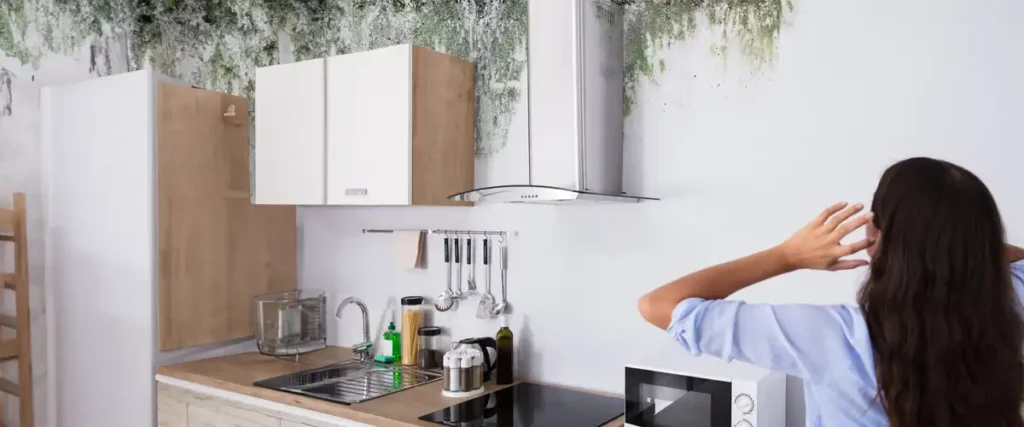Here’s an eye-opener: did you know that the cost of mold illness in the U.S. is a staggering $20 billion annually? Collins shares from the Institute for Green Science at Carnegie Mellon University. However, he emphasizes that “it is something we could eliminate at a fraction of the cost” with proper mold removal. And that is our focus today.
Beyond being unsightly, mold impacts our indoor air and health. But there’s hope! In this guide, we’ll dive deep into understanding decay—its effects and efficient strategies for mold management. Are you ready? Let’s dive in!

What are the Common Types of Indoor Mold?
1. Stachybotrys Chartarum (Black Mold)
Stachybotrys Chartarum (or Black Mold) is identifiable by its greenish-black hue and slimy texture. Typically found in damp areas, exposure can lead to symptoms like chronic coughing, persistent headaches, and irritations in the eyes, nose, and throat. Given the health risks, it’s vital to adopt specialized removal techniques.
2. Aspergillus
Aspergillus is a common mold found both inside and outside of homes. It presents a unique challenge due to its various colors and powdery form. While most people inhale Aspergillus spores daily without health repercussions, those with weakened immune systems may be at risk. Prolonged exposure can result in respiratory infections and severe allergies. Combatting this mold often requires specialized air filtration and meticulous cleaning.
3. Penicillium
Penicillium is another familiar indoor adversary, identifiable by its velvety texture in shades of blue or green. Known to exacerbate allergies and respiratory concerns, the best defense against its growth includes moisture management and air purification.
4. Cladosporium
With its suede-like appearance in shades of brown or olive green, this mold can thrive in various temperatures. When present, it may lead to respiratory problems and skin conditions. Effective remediation often entails the use of disinfectants and improved ventilation.
5. Alternaria
Alternaria, often found in showers and basements, boasts a dark green or brown velvety texture. Exposure can trigger allergic reactions and asthma. Swift removal combined with moisture management is crucial to counter this mold variety.

What are the Uncommon Types of Indoor Mold?
- Chaetomium: It starts as a gray, cottony patch that darkens over time. Though not common, it can cause skin problems and allergies. Handling this mold often requires experts due to its toughness.
- Fusarium: his mold sports colors from pink to white or mixed shades and prefers cold spots. It can trigger severe allergies and breathing issues, even rare. Quick expert action is vital to getting rid of it.
- Trichoderma: With white and wooly with occasional green spots, loves damp areas. Some types can release harmful toxins. You’ll need fast removal, dry conditions, and clean air to tackle it.

How Do We Approach Remediation for Various Mold Types?
Addressing mold isn’t just about cleaning it up. It’s about handling it safely and thoroughly and ensuring it doesn’t return. While approaches vary with mold type, mold removal is a process where some key steps apply to all:
- Personal Protective Equipment: Safety first! Always use PPE like masks, gloves, and goggles. This keeps you safe from breathing in mold or touching it, especially harmful ones.
- Containment and Isolation: Before cleaning, it’s vital to seal off the moldy area. This stops mold from moving elsewhere. Simple barriers or even specialized techniques can do the trick.
- Air Filtration and Ventilation: Clean air helps a lot. High-efficiency particulate Air (HEPA) filters catch tiny mold parts, so you don’t breathe them in. Plus, fresh air flow dilutes mold in the air.
- Cleaning and Removal Techniques: Different molds need different cleaning methods. Some might be cleared with usual cleaners; others need more specific care. After removal, clean and sanitize the spot to wipe out any left spores.
While the mold type may dictate the specific mold removal method required, the principles of safety, containment, and thorough cleaning remain consistent across all styles. Knowing how to handle mold makes our spaces safer and keeps them mold-free.

Prevention Strategies for Mold Prevention
Mold thrives in unchecked environments, but with a few vital preventive steps, its growth can be impeded:
- Controlling Moisture Levels: Address leaks promptly, use dehumidifiers in damp areas, and tackle water damages immediately.
- Regular Inspections: Periodically check mold-prone zones—like basements and bathrooms—for early signs, such as discoloration or musty odors.
- Proper Ventilation and Airflow: Enhance air circulation by using exhaust fans, opening windows in moist areas, and ensuring vents aren’t obstructed.
Integrating these simple measures can significantly minimize the risk of mold invasions, fostering a healthier living space.

Mold Management: Final Thoughts
By understanding the intricacies of different mold types and equipping ourselves with proactive prevention strategies, we’re not just addressing a household issue but protecting our health. With proactive prevention strategies, managing mold becomes less of a daunting household task and a routine, manageable endeavor. Engaging in consistent vigilance and regular checks, perhaps even considering professional services like mold removal in Shawnee, KS, are our allies in maintaining a mold-free environment.
Remember, mold might be persistent, but we’re always a step ahead with the right tools and insights. Let us keep our spaces not just clean but smartly protected. Together, we got this!
References:
- Centers for Disease Control and Prevention. (2022). Aspergillosis. https://www.cdc.gov/fungal/diseases/aspergillosis/index.html
- BROADFOOT, M. (2020, December). Keep indoor air clean during the pandemic with tips shared in the webinar. https://factor.niehs.nih.gov/2020/12/community-impact/indoor-air








